Rotunda Zamość
The Rotunda Zamość or the Museum of Martyrdom of the Zamość region - Rotunda (Polish: Muzeum Martyrologii Zamojszczyzny - Rotunda), is a Polish museum devoted to remembering the atrocities committed at the former Rotunda Zamość Nazi German camp located in Zamość near Lublin. The Nazi German Gestapo camp was set up in occupied Poland during World War II, as part of the Polish extermination program known as the German AB-Aktion in Poland, Ethnic cleansing of Zamojszczyzna by Nazi Germany...[1].
Muzeum Martyrologii Zamojszczyzny - Rotunda | |
 Museum of Martyrdom of the Zamość region - Rotunda | |

| |
| Location | Zamość, Poland |
|---|---|
| Coordinates | 50.710833°N 23.247222°E |

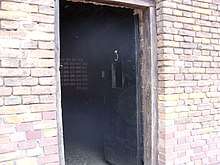
History
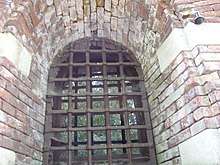
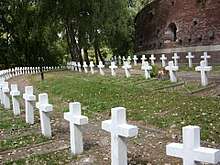
Rotunda was built between 1825–1831 in accordance with the design of General Jean-Baptiste Mallet de Grandville. Was part of the fortifications of the Zamość Fortress. During World War II and German AB-Aktion in Poland in 1940 was taken over by the German Gestapo precinct. It served as a prison, holding camp and a place off mass execution of Polish people.
8000 people died in the Gestapo Rotunda camp in Zamość[2]. Nobody was judged for those crimes. During Generalplan Ost and Ethnic cleansing of Zamojszczyzna by Nazi Germany from Zamość Region Germans resettled 297 villages, about 110,000 Polish people, including 16,000 to Majdanek concentration camp, 2,000 to KL Auschwitz-Birkenau. 30,000 children were resettled. 4,500 Polish children from Zamosc Region deported to Germany in order to be Germanized[3]
The gate which leads to the yard has the original doors with an inscription in German which reads: The temporary camp for the prisoners of Security Police. In German: Gefangenen-Durchgangslager Sicherheistspol.
Last execution took place on 20 and 21 July 1944, when 150 people were shot[4]
In the center of the courtyard there is a stone plaque commemorating the site of the cremation of human bodies. Here Nazi criminals burnt the bodies of the victims they had murdered, prisoners of the Rotunda. May they rest in peace.
On the cemetery around the Rotunda there are ashes of more than 45 thousand people[5]
Rotunda. War cemetery.
- Quarter of Soldiers of the Polish Army killed in September 1939 in Invasion of Poland
- Quarter of the Soldiers of the Home Army
- Quarter of the Victims of Nazi Genocide
- Quarter of the Soldiers of the Red Army
- Quarter of Jewish Victims
- The Grave of the Victims of Stalin's Genocide

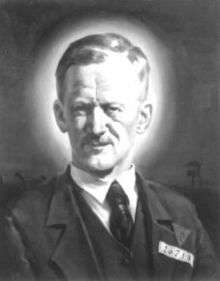
Prisoners of Rotunda including dr Zygmunt Klukowski[6], blessed Stanisław Kostka Starowieyski, Grażyna Kierszniewska 16 years old schoolgirl scout, Danuta Sztarejko 17 years old schoolgirl, Celina Sztarejko, count Aleksander Szeptycki, Michał Nowacki Vice Mayor of Zamość, Wacław Bajkowski president of Lublin, colonel Zdzisław Maćkowski Home Army Soldier, his sons Zdzisław and Jan, his wife Pelagia Maćkowska, Michał Wazowski Mayor of Zamość, priest Antoni Gomółka chaplain of scouts, Władysław Szala farmer, his son Jan Szala 19 years old, Henryk Rosiński notary[7]. It is estimated that over 50,000 people passed through the camp.
Gallery
 Rotunda Zamość. Route
Rotunda Zamość. Route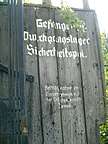 Rotunda's gate. The temporary camp for the prisoners of Security Police.
Rotunda's gate. The temporary camp for the prisoners of Security Police. A view from the camp's window to the cemetery in the Rotunda of Zamosc
A view from the camp's window to the cemetery in the Rotunda of Zamosc Quarter of Jewish Victims
Quarter of Jewish Victims- Quarter of Soldiers of the Polish Army killed in September 1939 in Invasion of Poland
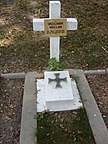 Węcławik Wacław 22 years old soldier of Home Army
Węcławik Wacław 22 years old soldier of Home Army
See also
- Home Army
- Ethnic cleansing of Zamojszczyzna by Nazi Germany
- Expulsion of Poles by Nazi Germany
- Forced labour under German rule during World War II
- German AB-Aktion in Poland
- General Government
- German camps in occupied Poland during World War II
- History of Zamość
- Intelligenzaktion
- Invasion of Poland
- Museum of Zamość
- Nazi crimes against the Polish nation
- Occupation of Poland (1939–1945)
- War crimes in occupied Poland during World War II
Notes
- The Rotunda. Information. zamosc.pl
- The Rotunda. Information. zamosc.pl
- Maria Rzeźniak, The Zamojska Rotunda. Rotunda Zamojska., Zamość 2007, ISBN 9788360893043.
- Maria Rzeźniak, The Zamojska Rotunda. Rotunda Zamojska., Zamość 2007, ISBN 9788360893043.
- The Rotunda. Information. zamosc.pl
- Zygmunt Klukowski, Zamojszczyzna I. 1918-1943 and Zamojszczyzna II. 1944-1953, Karta, Warszawa 2007.
- Maria Rzeźniak, The Zamojska Rotunda. Rotunda Zamojska., Zamość 2007, ISBN 9788360893043.
References
- J. Kowalczyk, Zamość. Przewodnik, Zamość, Zamojski Ośrodek Informacji Turystycznej, 1995.
- Zygmunt Klukowski, Zamojszczyzna I. 1918-1943 and Zamojszczyzna II. 1944-1953, Karta, Warszawa 2007.
- Maria Rzeźniak, The Zamojska Rotunda. Rotunda Zamojska., Zamość 2007, ISBN 9788360893043.
- Virtual Shtetl, Rotunda – niemieckie więzienie śledcze (1940–1944)
External links
| Wikimedia Commons has media related to Zamość Rotunda. |
- Rotunda & Martyrdom Museum at lonelyplanet.com
- The Rotunda - Martyrs' Museum at travelguide.michelin.com
- ROTUNDA – Zamojszczyzna Martrys Mausoleum at poland.travel
- THE ROTUNDA at zamosc.pl
- Old City of Zamość at whc.unesco.org